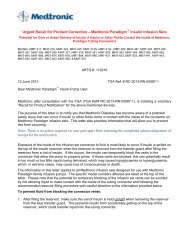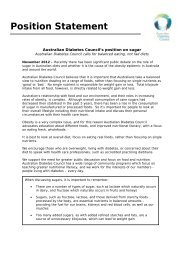- Page 1: National Evidence Based Guidelinesf
- Page 4: Research OfficersMs Linda SmithPodi
- Page 7 and 8: 2.2 Issues for Foot Problems in Typ
- Page 9: • Aim to achieve the best possibl
- Page 12 and 13: Background - Peripheral Neuropathy
- Page 14 and 15: proportion of subjects with a durat
- Page 16 and 17: and an OR 1.1-7.8. This study also
- Page 18 and 19: Summary - Peripheral Neuropathy as
- Page 20 and 21: Section 2: Diabetes Foot ProblemsIs
- Page 22 and 23: predicting risk of amputation, 2.9
- Page 24 and 25: Summary - Peripheral Vascular Disea
- Page 28 and 29: Evidence - Foot Deformity and Previ
- Page 30 and 31: people with both LJM and neuropathy
- Page 32 and 33: Summary - Foot Deformity and Previo
- Page 34 and 35: Section 4: Diabetes Foot ProblemsIs
- Page 36 and 37: Also in the Seattle study, 67 peopl
- Page 38 and 39: Summary - Ulcer as a Risk Factor fo
- Page 40 and 41: Section 5: Diabetes Foot ProblemsIs
- Page 42 and 43: The other frequently reported metho
- Page 44 and 45: side; and 82% having the same resul
- Page 46 and 47: Evidence Table: Section 5Detection
- Page 48 and 49: Background - Clinical Detection of
- Page 50 and 51: pulse was bilaterally absent in 1.8
- Page 52 and 53: Evidence Table: Section 6AuthorClin
- Page 54 and 55: Background - Frequency of Foot Exam
- Page 56 and 57: Summary - Frequency of Foot Examina
- Page 58 and 59: Section 8: Diabetes Foot ProblemsIs
- Page 60 and 61: Behaviour assessment scores, measur
- Page 62 and 63: Mazzuca et al (1986) studies 532 pe
- Page 64 and 65: with before the programme, after 1-
- Page 66 and 67: Evidence Table: Section 8AuthorEffe
- Page 68 and 69: Background - Glycaemic Control and
- Page 70 and 71: In a previous Japanese randomised s
- Page 72 and 73: Evidence Table: Section 9AuthorGlyc
- Page 74 and 75: Background - Footwear to Reduce Ulc
- Page 76 and 77:
period. In addition people without
- Page 78 and 79:
Comparisons of in-shoe foot pressur
- Page 80 and 81:
The rate of plantar callus formatio
- Page 82 and 83:
Evidence Table: Section 10AuthorFoo
- Page 84 and 85:
Background - Foot Clinics and Multi
- Page 86 and 87:
A prospective non randomised contro
- Page 88 and 89:
Summary - Foot Clinics and Multi-di
- Page 90 and 91:
Section 12: Diabetes Foot ProblemsI
- Page 92 and 93:
and/or osteomyelitis; III - fore-fo
- Page 94 and 95:
Summary - Economic consequences•
- Page 96 and 97:
Section 13: Diabetes Foot ProblemsI
- Page 98 and 99:
Some ethnic groups are associated w
- Page 100 and 101:
Evidence Table: Section 13AuthorSoc
- Page 102 and 103:
Calle-Pascual AL, Duran A, Diaz A,
- Page 104 and 105:
Jannink MJ, van Dijk H, de Vries J,
- Page 106 and 107:
Moss SE, Klein R, Klein BE. The 14-
- Page 108 and 109:
Soulier SM, Godsey C, Asay ED, Perr
- Page 110 and 111:
Diabetes Foot Problems: General Ref
- Page 112 and 113:
McNeely MJ, Boyko EJ, Ahroni JH, St
- Page 114 and 115:
Diabetes Foot Problems: Other Refer
- Page 116 and 117:
Caputo GM, Cavanagh PR, Ulbrecht JS
- Page 118 and 119:
Garbalosa JC, Cavanagh PR, Wu G, Ul
- Page 120 and 121:
Lavery LA, Armstrong DG, Wunderlich
- Page 122 and 123:
Payne C. Regional variations of dia
- Page 124 and 125:
Tovi J, Svanborg E, Nilsson BY, Eng
- Page 126 and 127:
Criteria used to determine the suit
- Page 128 and 129:
QUESTIONS KEY WORDS NO.ARTICLESIDEN
- Page 130 and 131:
QUESTIONS KEY WORDS NO.ARTICLESIDEN
- Page 132 and 133:
QUESTIONS KEY WORDS NO.ARTICLESIDEN
- Page 134 and 135:
QUESTIONS KEY WORDS NO.ARTICLESIDEN
- Page 136 and 137:
QUESTIONS KEY WORDS NO.ARTICLESIDEN
- Page 138 and 139:
QUESTIONS KEY WORDS NO.ARTICLESIDEN
















